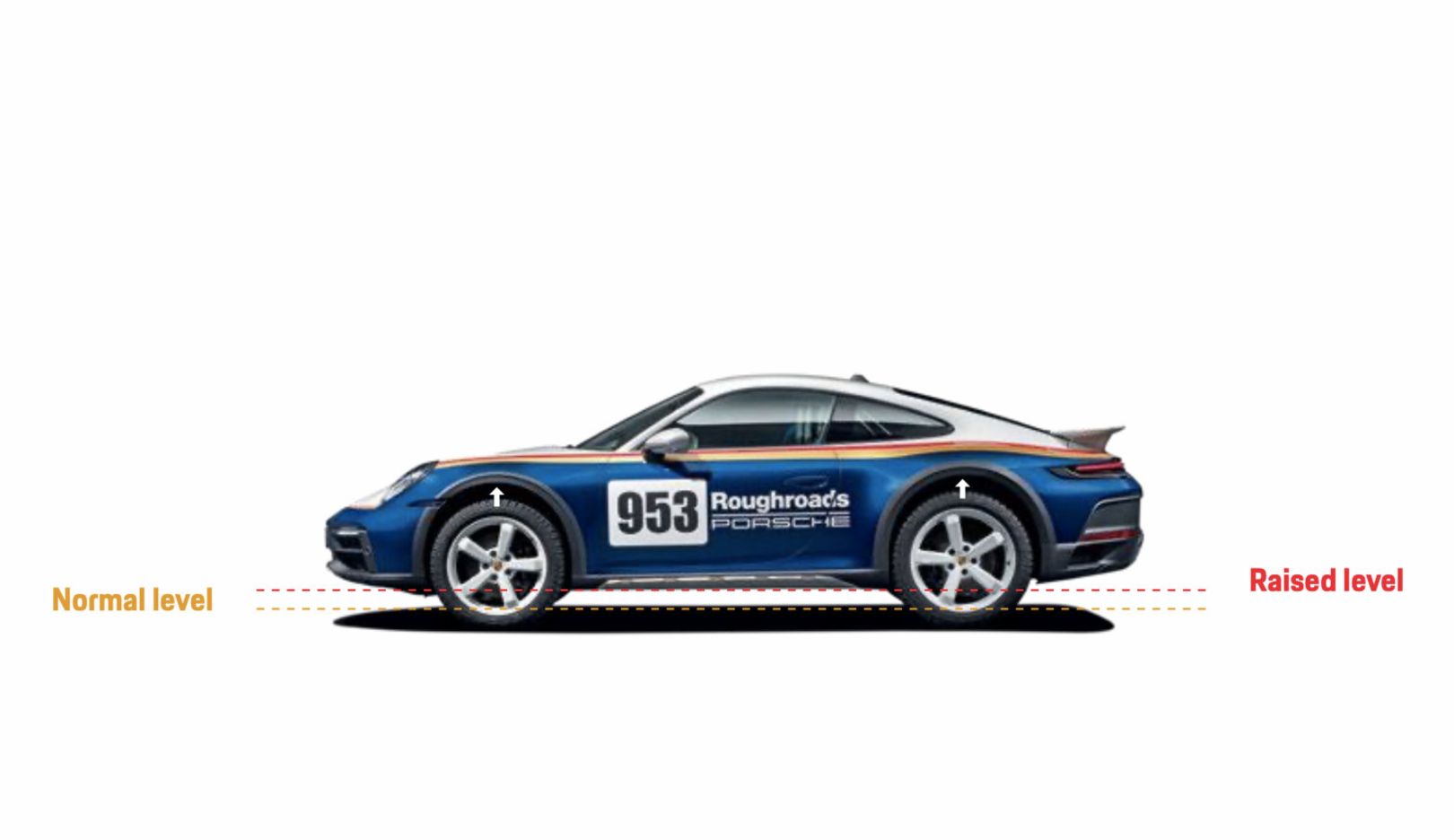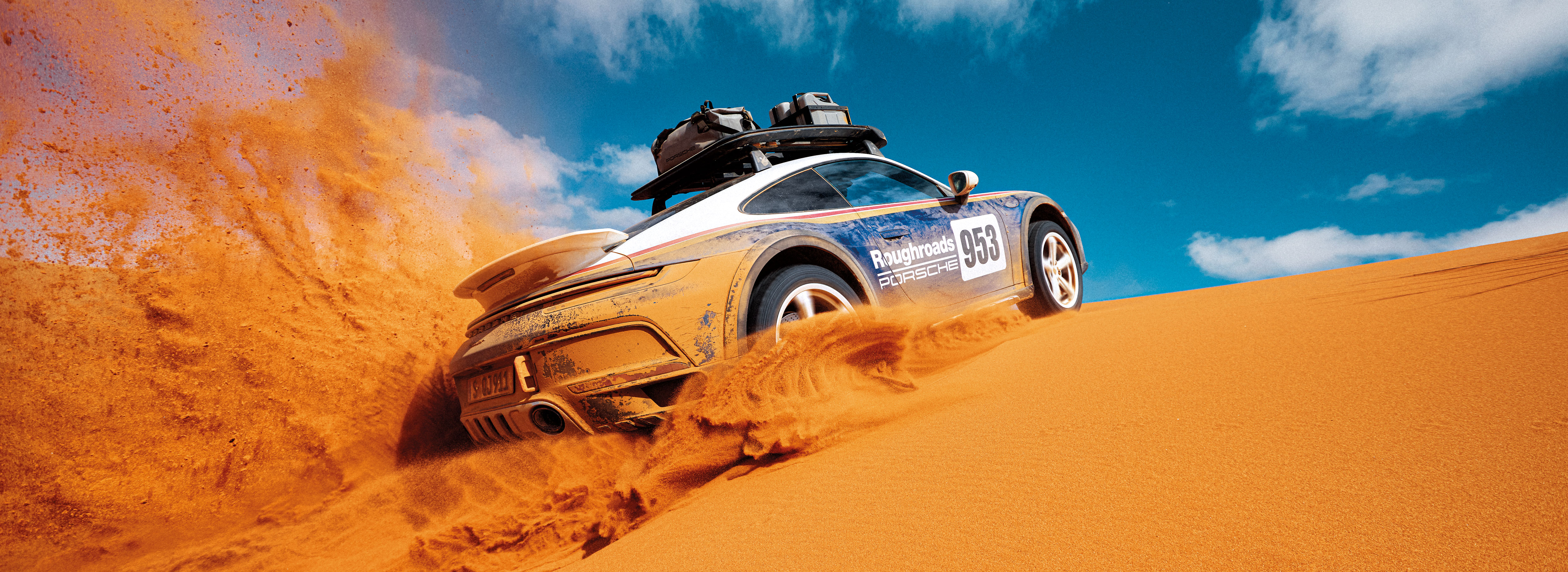That is why the chassis of the 911 Dakar is the most versatile sports chassis in the world
Ice and rally tracks, desert seas and scree: for optimum handling, Porsche combines the off-road characteristics of an SUV with the agility of a sports car in the 911 Dakar.
Achim Lamparter uses superlatives sparingly. The General Project Manager for the Porsche 911 Dakar prefers not to claim his car has the most versatile chassis in the world. But then he gets more specific: “It’s the most versatile for a sports car, yes. The Dakar is definitely the vehicle with the broadest spread of capabilities in this segment.”
In comparison to a “normal” 911 with a sports suspension, the 911 Dakar is supported by struts that raise the body 40 millimeters higher above the ground. The standard all-terrain tires with high sidewalls add a further ten millimeters. The clever feature here is the hydraulic lift system. Developed for the front axle of very low-slung sports cars, it is also featured on the rear axle of the Dakar, enabling the body to be raised by a further 30 millimeters. The result is maximum ground clearance of 191 millimeters– on par with some SUVs.

Lift system:
At its normal level, the sports chassis is approximately 50 millimeters higher than in a 911 Carrera. At its raised level, a lift system elevates the chassis’s front and rear axles by an additional 30 millimeters.Does being tall equate to being stiff? No – the 911 Dakar can handle the Nordschleife, and masters corners, top track speeds, and changes in pace as a 911 should. It can’t match the current 911 GT3 models, which of course have a very different, more track-focused mission. “But its lap time is on a par with a 996 GT3 – in spite of its all-terrain tires and a top track speed limited to 240 kmh.” ()
Porsche did everything it could to enhance driving stability in the all-wheel drive vehicle. The car offers not only Porsche Active Suspension Management (PASM) as standard, but also rear-axle steering, Porsche Dynamic Chassis Control (PDCC), and PTV Plus in conjunction with an electronically controlled rear differential lock with fully variable torque distribution. The goal of all these systems is to optimize grip, performance, and driving pleasure in any situation.
Be it on sand, serpentine roads, or snow, the stability programs calculate the optimum interplay for every situation. Only then can the Dakar offer its impressive capabilities off-road, too. Two new driving programs were developed for the 911 – “Rally” for spirited driving on loose surfaces such as gravel and “Off-road” with the emphasis on traction. With this program, the lift system is activated automatically and offers the body maximum ground clearance up to a track speed of 170 kmh – almost as much as the Cayenne.
9:11 Magazine
The new all-wheel 911 in the 9:11 Magazine – episode 23 (Sporting Spirit) is available here.
The basic concept and chassis electronics of the Dakar meant that programming work was needed in particular. The integration engineers attended all the testing performed around the world and focused on all the many application programs, in other words the software for the regulation systems. A 50 percent reduction in the spring rates, spring compression and extension increased to up to 14.5 millimeters, and installation of the more rigid engine mounts of the current 911 GT3 – this is all hardware, classic engineering. But nothing works without the experts with the laptop. Porsche Stability Management (PSM) had to learn the difference between cobblestones and desert sand, too. “My coworkers modified their applications on-site and we were able to test this right away,” says Lamparter. Some 2,000 hours of work were invested in the PSM application.
But chassis modifications are no use if the tires are unable to implement them. Lamparter therefore raves about what Pirelli achieved for the Scorpion All Terrain Plus. “It was already in a super state in the first development stage. And we were already thinking about offering the tire as standard back then.” Because the Pirellis were impressive on asphalt, too. “On the circuit, this tire wears more slowly than some road tires,” says Lamparter. “That’s black magic,” he adds with a grin.
Or it’s the result of engineering expertise. After all, the tire works together with the most versatile sports car chassis in the world.
Rough Roads to 911 Dakar
From the test drives on the ice through to the debut in the South African desert. Discover the book accompanying the offroad sports car in the store.
Consumption data
911 GT3 (2023)
911 GT3 RS
-
13.2 l/100 km
-
299 g/km
-
G Class
911 GT3 with Touring Package (2023)
-
12.9 l/100 km
-
293 – 292 g/km
-
G Class
-
G Class




